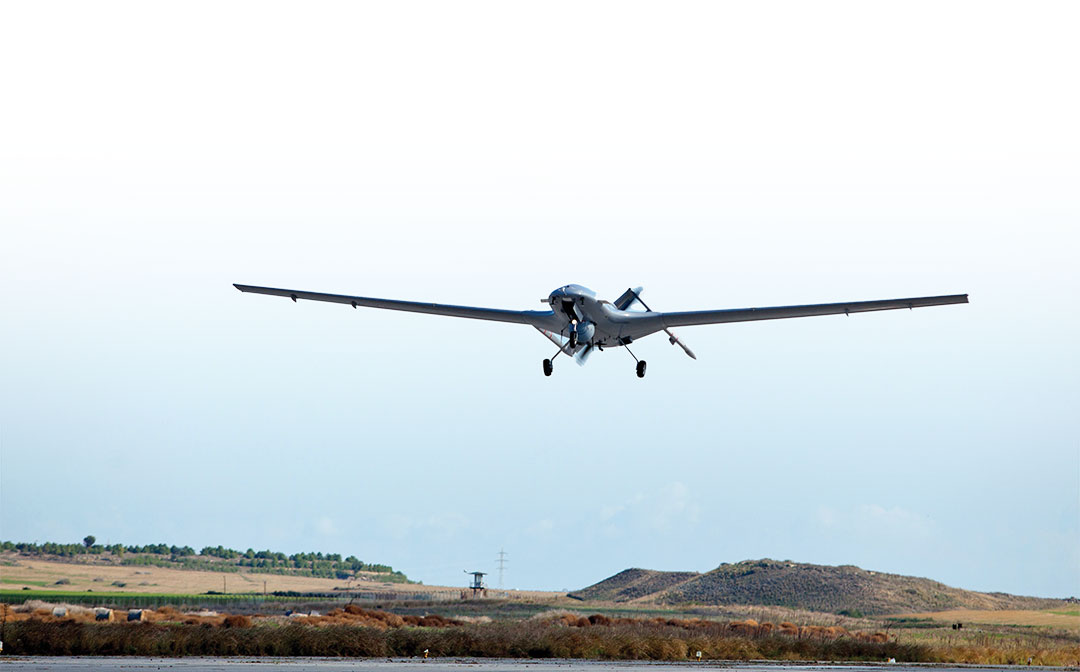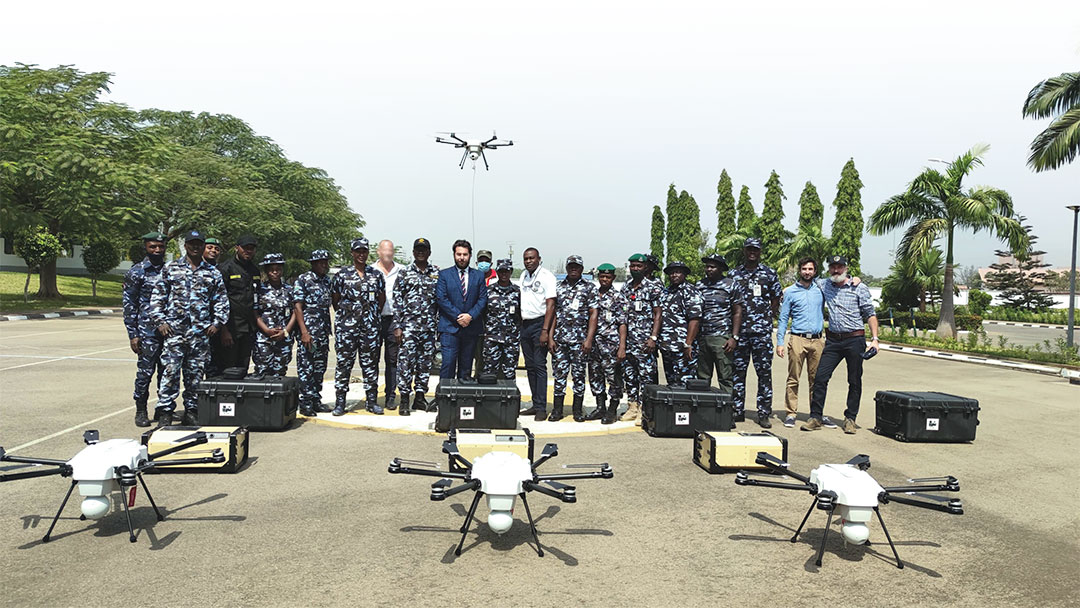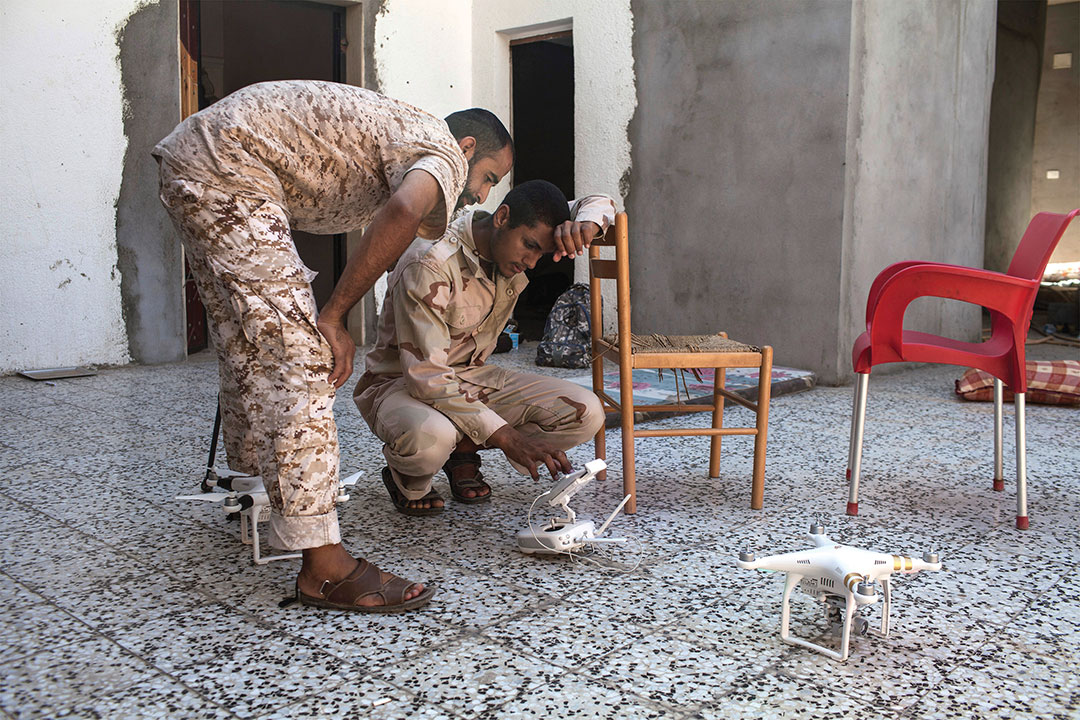ADF STAFF
Nigeria deploys drones at border crossings to increase security along its porous frontier and to identify potential threats while they’re still several kilometers away.
The Orion drones, manufactured by the French-American company Elistair, operate at the end of a 100-meter Kevlar cord. The tether provides power for up to 50 hours of flight time and secure, unjammable communication with operators. The drones are part of Nigeria’s fleet of unmanned vehicles that makes it one of the continent’s major players in drone technology.
The terrorists that Nigerian authorities are looking for likely are watching them with drones of their own. According to analysts, terrorist groups such as Boko Haram and its offshoot, the Islamic State West Africa Province, use them for intelligence-gathering while also experimenting with turning inexpensive, commercially available drones into flying improvised explosive devices (IEDs) that they can use to launch attacks on civilian and military targets.
Nigeria is representative of Africa at large as the rapid proliferation of drone technology hints at a looming arms race. Already, drones are reshaping the way militaries from Morocco to South Africa protect their citizens, monitor their coastlines, combat wildlife poaching and more.
The growth of military-grade drone technology runs parallel to the accelerating availability of civilian-grade commercial drones, many of them made and marketed by China, that have the potential to be weaponized by extremist groups.
“It’s an unsophisticated technology that gains sophistication quickly,” Adam Rosman, managing director of South African drone manufacturer Aerial Monitoring Solutions, told ADF. “There is a lot of possibility in Africa.”

Who Has Drones?
The first drones deployed in Africa took to the skies in 1978, launched by South Africa to monitor the civil war in what was then Rhodesia. South Africa produced the continent’s first homegrown drones, also known as unmanned aerial vehicles (UAVs), in the late 1980s. The use of modern drones began in 2001 when Botswana ordered a number of Israeli-made Silver Arrow Micro-V UAVs. Since then, drones increasingly have become must-have technology for governments across the continent.
Nearly every country on the continent uses drones in some form. In most cases, those uses are peaceful — from delivering health care supplies to remote communities to monitoring wildlife preserves under threat from poachers. The COVID-19 pandemic cast a spotlight on Africa’s nascent drone capacity as countries used aerial and ground-based drones to deliver vital public health information and to monitor lockdowns.
“The African continent is becoming a key site for the adaptation of drones to many military and nonmilitary purposes,” Nicholas Heras, senior director for strategy and innovation at the New Lines Institute for Strategy and Policy, told ADF.
Nations are less transparent about their drone use when it comes to their militaries. Critics say that lack of transparency leads to concerns about whether drones are being used in accordance with international human rights standards and traditional rules of engagement.
“This hinders open debates on the military use of drones in Africa,” the Netherlands-based peace organization PAX commented in a report on drone use on the continent. The PAX report listed 20 countries in North Africa, the Sahel and the Horn of Africa that have acquired military-grade drones. Morocco also manufactures them.
“An uncountable number of drones are increasingly monitoring and impacting lives all over North Africa, the Sahel and Horn of Africa,” PAX reported.
In Sub-Saharan Africa, South Africa has become another major actor in the drone industry. South Africa manufactures drones for sale to other countries and has considered deploying them along its 5,244-kilometer border. Nigeria also makes its own drones. Cameroon acquired small military drones in 2018. Kenya has deployed drones to monitor al-Shabaab insurgents in neighboring Somalia. The Democratic Republic of the Congo and Mozambique also have deployed drones in combat.
Botswana, Côte d’Ivoire, Sudan and Zambia have added mid-sized tactical drones to their military fleet. The success of Turkish Bayraktar TB2 drones in Libya’s civil war raised the profile of the weaponized drones, and militaries in Ethiopia, Morocco, Rwanda, Togo and Tunisia have acquired them. Angola is considering adding them as well.
“Turkey’s drone use in Libya demonstrated to middle- and lower-middle-income nations across the world that drones would provide them with an air force on the cheap that could have devastating impacts on the battlefield,” Heras said.

A Force Multiplier — With Limits
Whether they’re tracking illegal fishing boats at sea, pursuing poachers across a wildlife preserve or launching attacks against terrorist cells, drones have become a force multiplier for security agencies across the continent.
“The use of UAS [unmanned aerial systems] represents a new iteration of digital technology,” analyst Karen Allen wrote for the Africa Center for Strategic Studies.
The low cost of drone technology relative to a full-scale naval ship or air force jet means that cash-strapped militaries can add capabilities on a shoestring. Drones with infrared technology can see in the dark, a useful tool for observing poachers who often operate under the cover of night. They also can hover over a target or even follow one for an extended period. Their small profile makes them hard to spot and harder to shoot down.
The presence of drones above a fishing vessel, along a border or above a wildlife park also can sow doubts in the minds of would-be bad actors — doubts that can make them halt illegal operations, according to Rosman.
Despite their capabilities, drones have limits. They can be disabled through jamming or hacked and turned against their operators. They can be grounded by sandstorms, dense tree canopies or thick clouds, all conditions found routinely across Africa.
Drones also operate for limited amounts of time before having to refuel or recharge. That can make it a challenge to cover vast distances effectively.
“A drone is not a silver bullet that is going to solve all your problems,” Rosman told ADF. “You need people on the ground.”
Those limitations often are ignored in favor of the mystique associated with drone technology, he added. African leaders are bombarded with pitches from countries and companies eager to sell them drone technology, some by making promises their equipment can’t keep.
On top of that, military leaders sometimes expect drones to do things they’re simply not capable of, such as see inside a tank.
“You can always tell what movies they’ve been watching,” Rosman said.
The quest for the most advanced drones has produced a jumble of technology from multiple countries, including China, Iran, Israel and Turkey. Users navigate a hodgepodge of software and languages, according to Rosman.
After buying the technology, some leaders then refuse to spend the extra money to train operators, opting to have them figure it out on their own. That “do-it-yourself” approach can result in drones lost on the bottom of the ocean or lying in a pile of wreckage on the ground. Other times, the equipment goes nowhere at all.
“There’s a huge amount of equipment on this continent that’s not being used,” Rosman said.

AI Arms Race
In their rush to buy drones, African nations soon could find themselves becoming the testing ground for the next step in drone technology: artificial intelligence.
“Africa is an emerging market for this trend,” Heras told ADF. “When paired with potential military capabilities, it could be a key site for prototyping autonomous drones in military contexts.”
The Libyan civil war might have already provided a glimpse of that future. With nearly 1,000 drone-based air strikes, Libya became a showcase for using them in combat. U.N. Special Representative to Libya Ghassan Salame called the conflict “the largest drone war in the world.”
From that battlefield emerged a United Nations report suggesting that an AI-equipped Turkish Kargu-2 drone may have, in the report’s words, “hunted down and remotely engaged” enemy fighters without orders from human operators.
The Kargu-2’s developer describes the quadcopter drone as designed for loitering above a target with fully autonomous navigation and precision-strike capabilities. The strike action requires a human handler to be involved, according to the Kargu-2’s website.
It’s unclear, however, whether that is how the attack actually happened, according to the U.N. report.
“Once in retreat, they were subject to continual harassment from the unmanned combat aerial vehicles and lethal autonomous weapons systems,” the report’s authors wrote.
Zachary Kallenborn, a part-time fellow at the Center for Strategic and International Studies’ Strategic Technology Program who studies drones, told The New York Times that the report suggested that for the first time an AI-capable weapons system independently found and attacked people.
Kallenborn told ADF all the components needed to create such a drone already exist.
The Future: Swarm Attacks
Libya’s experience with drones has been unique to the continent, according to Brendan Cannon, who studies the implications of drone technology at Khalifa University in the United Arab Emirates. But that may not be the case for much longer.
“I would say that an arms race is in the offing but getting a slow start for reasons related to resource constraints and the availability of drones,” Cannon told ADF in an email. When that arms race begins, it could play to the strengths of extremist groups if countries are not careful, he added. Commercially available drones could be turned into weapons despite being able to carry only light payloads.
“It will potentially give them an advantage to prosecute armed attacks (albeit on a small scale) on soft but highly visible targets of state power, such as presidential palaces or police stations on account of inadequate, to no air defenses in most states,” Cannon said.
Kallenborn said software advances could help extremists counter governments’ military-grade technology by using dozens or hundreds of commercially available drones to create “swarm” attacks.
For the first time in history, drone technology has created the potential for nonstate actors to control the skies over a given area, Kallenborn told ADF.
Allen has suggested that countries combat the potential drone arms race by closely monitoring and possibly restricting imports of drone technology — a tactic other analysts see as difficult to execute effectively, given the continent’s porous borders and the many legitimate uses for commercial drones. Groups could import racing drones, for example, and convert them to flying IEDs, Rosman said.
“There is currently no effective counter to the use of drones in this manner,” Heras said. “The effects of nonstate forces using large fleets of small, highly mobile, low-profile commercial drones against most African militaries should keep general staffs across the continent up at night.”

